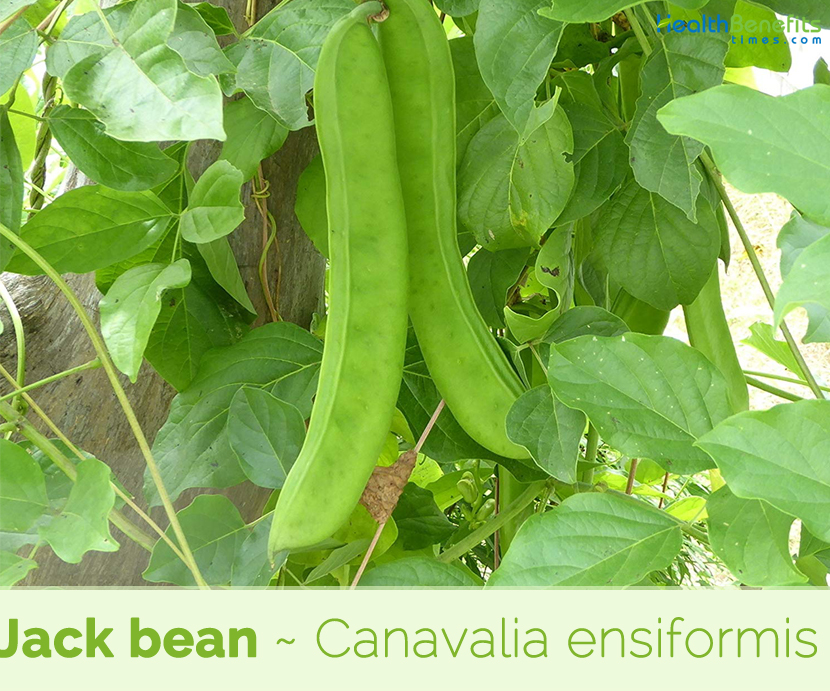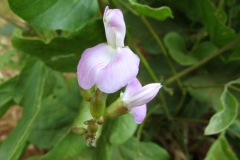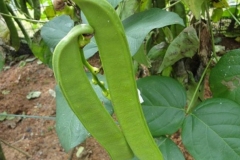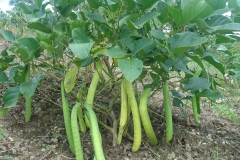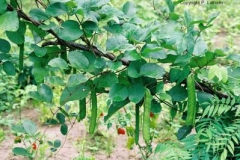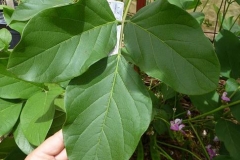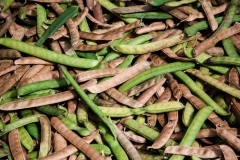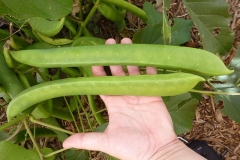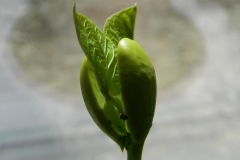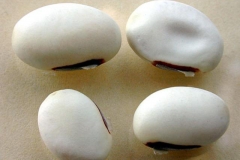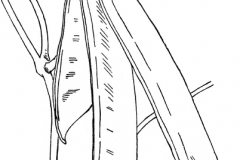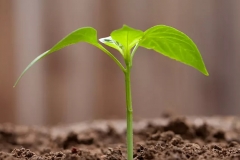Plant Description
Jack Bean is a drought-tolerant, fast-growing, sometimes shrubby twining annual to short-lived perennial plant that grows about 50 – 200 cm tall but can become up to 10 meters long when climbing, its stems supporting themselves by twining around other plants. The plant has the ability to continuously grow under severe environmental conditions, even in nutrient-depleted, highly leached, acidic soils. Jack bean is drought-resistant and immune to pests. It can grow in poor droughty soils, and does not grow well in excessively wet soil. It will drop its leaves under extremely high temperatures, and may tolerate light frosts as well. The plant is woody with a strong, long tap root system. Its roots have nodules which fix nitrogen.
Leaves
Leaves arise alternately and are trifoliate. The 8 in (20 cm) long and 4 in (10 cm) wide leaves have three egg-shaped leaflets that are wedge-shaped at the base, and taper towards the tip. The center leaflet is slightly elongated. Petioles are as long as the leaflets.
Flowers & Fruits
Flowers are typically papillionaceous rose-colored, purplish, or white with a red base, rounded; about 1 in (2.5 cm) long; up to 20 may develop in groups of 2-3 on each peduncle. Fertile flowers are followed by 12 in (30 cm) long, 1.5 in (3.8 cm) wide, sword-shaped seedpod that are linear, slightly curved and contain 1-2 cm long, ellipsoid seeds. The pods are light brown when ripe, ribbed near the upper suture and may contain up to 20 seeds per pod. Seeds are white and smooth with a brown seed scar that is about one-third the length of the seed.
Health benefits of jack Bean
Listed below are few of the health benefits of using jack Bean
1. Reduced Cancer Risk
Jack beans help to lower a person’s risk of having cancer. It consists of antioxidants that protect the cells from ending up mutated. Also, jack beans have anti-inflammatory properties. Experts say that cancer is not the only problem that can stem from inflammation, but also diabetes, arthritis and heart disease.
2. Improved Gut Health
Jack bean is rich in fiber, the consumption of jack beans helps in the removal of toxins and waste products in the gut. Needless to say, jack beans help in the prevention of constipation and abdominal distention, as well as a bunch of other problems concerning the digestive system.
3. Reduced Weight
Low in fat and high in fiber, jack beans are perfect for individuals who like to lose weight. Even a small serving of these legumes is enough to make the stomach feel really full, therefore preventing overeating and hunger pangs. Jack beans are excellent non-animal sources of protein, which is a nutrient that helps speed up the metabolism.
4. Healthier Heart
Regular consumption of jack beans can actually help keep heart disease at bay. Being rich in fiber and antioxidants, jack beans help in lowering bad cholesterol levels. Also, these healthy legumes help keep the blood pressure from rising, therefore reducing a person’s risk of having heart disease.
5. Increased Muscle Mass
Everyone knows that protein is something so important for building as well as repairing muscles. Having bigger muscles is vital for strength and endurance. Such is also beneficial for anyone who wants to keep his or her ideal weight intact because muscles burn lots of calories every single time.
6. Stronger Immune System
Jack beans consists of good amount of vitamin C, which is the single most important vitamin for making the immune system more capable of defending the body against disease-causing microorganisms like bacteria and viruses. Particularly when the flu season is nearing, the addition of jack beans in the diet can be so advantageous.
7. Lovelier Skin
Vitamin C is also important for keeping the skin healthy and pretty. That’s because the nutrient is essential for the growth of new skin cells. What’s more, it acts as an antioxidant that neutralizes free radicals. Vitamin C is also important for the production of collagen, a skin-firming type of protein.
Traditional uses and benefits of Jack Bean
- In China, the whole plant is pounded and applied to boils.
- Seed is used as a bechic, stomatic, and tonic, also to strengthen the kidney.
- Jack bean seed is used as an antibiotic and antiseptic in Nigeria.
- Traditional medicinal uses of C. gladiata include the treatments of vomiting, abdominal dropsy, kidney-related lumbago, asthma, obesity, stomach- ache, dysentery, coughs, headache, intercostal neuralgia, epilepsy, schizophrenia, inflammatory diseases and swellings in Korea.
- It is also used for treating ozena, hemorrhoids, pyorrhea, otitis media, boils, cancers, inflammatory diseases and atopic dermatitis in japan.
- Jack bean extract is used in soap for the treatment of athlete’s foot and acne in Korea.
- Leaves were used by the Malays in treating gonorrhea In Peninsular Malaysia.
- Leaves were used with other substances in a kind of magic tonic that was squeezed into the eyes.
- The plant was pounded and applied to boils.
- The seeds were also used medicinally.
- It is used in the treatment of vomiting, abdominal dropsy, kidney-related lumbago, asthma, obesity, stomach-ache, dysentery, coughs, headache, intercostal neuralgia, epilepsy, schizophrenia, inflammatory diseases and swellings in Korea.
- Soap is marketed there which is based on extracts of jack bean; it is used for the treatment of athlete’s foot and acne.
Culinary Uses
- Very young seedpods, before the seeds swell within, can be eaten raw.
- They are also cooked like French beans and used as a vegetable.
- Unripe seeds are cooked and eaten like broad beans.
- The roasted seed is used as a coffee substitute.
- Young leaves are cooked and like spinach.
- In some tropical parts of the world where jack bean is available, its young leaves and green pods are used as vegetables.
- Young pods are sliced and cooked or eaten raw.
- Young, tender pods are processed into several kinds of pickles called Fukujin-zuke, Nukazuke and Miso zuke in japan.
- Young leaves and flowers are steamed and used as flavoring in Java.
- Seeds are used as substitute for coffee in Cuba.
- Young seedpods raw or more commonly cooked and used as a vegetable.
Other facts
- The mature bean contains potentially harmful saponins, cyanogenic glycosides, terpenoids, alkaloids, and tannic acid and must be cooked before eating.
- In several homes in Nigeria, jack bean is grown as an ornamental plant.
- In some areas in the country it is regarded as snake repellent.
- The seed is used as feed for cattle and chicken, but if eaten in considerable quantity dry seeds may cause poisoning.
- It is often grown as a cover crop, green manure and forage crop.
- Its foliage provides a good leaf meal for use in animal feeds.
- In African countries the species is sometimes a fetish plant.
- The plant is sometimes grown as a green manure crop or as a temporary ground cover.
References:
https://www.itis.gov/servlet/SingleRpt/SingleRpt?search_topic=TSN&search_value=501179#null
https://davesgarden.com/guides/pf/go/60529/
https://npgsweb.ars-grin.gov/gringlobal/taxonomydetail.aspx?id=8827
https://www.cabi.org/ISC/datasheet/14486
https://plants.usda.gov/core/profile?symbol=caen4
http://www.theplantlist.org/tpl/record/ild-3629
https://en.wikipedia.org/wiki/Canavalia_ensiformis
https://plants.usda.gov/plantguide/pdf/pg_caen4.pdf
Comments
| Jack bean Quick Facts | |
|---|---|
| Name: | Jack bean |
| Scientific Name: | Canavalia ensiformis |
| Origin | Tropical Africa and Central and South America from Mexico south to Brazil and Peru, and to the West Indies |
| Colors | Green when young turning to light brown when ripe |
| Shapes | Sword-shaped seedpod are linear, slightly curved, up to 12 in (30 cm) long, 1.5 in (3.8 cm) wide and contain 1-2 cm long, ellipsoid seeds |
| Taste | Sweet |
| Health benefits | Reduced Cancer Risk, Improved Gut Health, Reduced Weight, Healthier Heart, Increased Muscle Mass, Stronger Immune System, Lovelier Skin |
| Name | Jack bean |
|---|---|
| Scientific Name | Canavalia ensiformis |
| Native | Tropical Africa and Central and South America from Mexico south to Brazil and Peru, and to the West Indies |
| Common Names | Jack bean, Sword bean, Giant stock-bean, Wonder bean, gotani-bean, horse-bean, seaside-bean, Chickasaw, limabean, Overlook Bean, Sabre-Bean, Brazilian broad bean, Coffee bean, Chickasaw lima bean, Ensiform bean, Mole bean, Pearson bean |
| Name in Other Languages | Arabic: Fâsûlyâ seyfîyah, Fûl Hindî Brazil: Feijão-de-porco Chinese: Yang dao dou, Da dao dou, Dao dou, Bai dao dou, Jiān è dāo dòu (尖萼刀豆) Cuba: Frijol Café, Frijol De Machete Danish: Jackbønne, Sabelbønne, Svaerdbønne Dutch: Kara bendo, Zwaardboon English: Jack bean, Sword bean, Giant stock-bean, Wonder bean, gotani-bean, horse-bean, seaside-bean, Chickasaw, limabean, Overlook Bean, Sabre-Bean, Sword jackbean Esperanto: Glavfabo Estonian: Mõõkjas kanavaalia French: Haricot sabre, Pois sabre, Haricot sabre à grain blanc, Fève Jacques, Haricot de Madagascar, pois gogane, Gros Pois, Pois de Sabre German: Jackbohne, Madagaskarbohne, Schwertbohne, schwertförmige Strandbohne Hindi: Bara Sem, Jangli Sem, Kadsambal, Sufed Kadsumbal, Lalkudusumpal Indonesia : Kacang Nyonya, Kacang Prasman, Kara Wedung, Koas Pedang, Krandang, Kara Bedog, Koas Bakol, Koas Bebedogan, Koas Parasman Italian: Canavalia Japanese: Tachi nata mame (タチナタマメ), Shiro nata mame , Tsurunachi nata mame Kannada: Shambee Avare, Thumbe Kaayi Khmer : Tioeuhs Kinyarwanda: Burunga, Etsungu, Inganigani Korean: Jagdukong, jul jak du kong (줄작두콩) Laotian : Khùa, Khao Khieo Malay: Kacang parang, Kacang polong, Kacang parasman, Kara pedang, Koas bakol Malaysia : Kacang Hantu, Kacang Parang, Kacang Polong Malayalam: Bara-Mareca, Valamara, Valpayar, Valvara Philippines : Magtambokau, Habas Portuguese: Feijão espada, fava-branca, feijão-bravo, feijão-de-cobra, feijão-de-porco, feijão-de-quebranto, mangolô Sanskrit: Asisimbi, Asisimbi, Mahasimbi Sinhalese: Awara, Bu-wal-awara, Wal-awara Spanish: Frijol de bibijagua, Frijol de sable, Frijol espada, Judía sable, Haba de burro, Haba blanca, Haba criolla, Haba de caballo Swahili : Mwingasiafu, Mbwanda Swedish: Jackböna Tagalog: Habas Tamil: Araniyamutkam, Civapputtampattai, Kattavarai, Kattavaraikkoti, Kayilakakkoti, Kayilakam, Peyavarai, Segapputampattai, Segapu Thampattai Thai : Thua-Phra Vietnamese : Daaju Ruwja, Dau Rua Visayan: Magtambokau |
| Plant Growth Habit | Drought-tolerant, fast-growing, sometimes shrubby twining annual to short-lived perennial plant |
| Growing Climates | Ability to continuously grow under severe environmental conditions |
| Soil | Can even grow in nutrient-depleted, highly leached, acidic soils |
| Plant Size | 50 – 200cm tall but can become up to 10 meters long |
| Root | Strong, long tap root system |
| Leaf | Arise alternately and are trifoliate. Leaflets, commonly up to 12 cm long, are ovate-elliptic. The center leaflet is slightly elongated. Petioles are as long as the leaflets |
| Flower | Typically papillionaceous, rose to purple in color, rounded, about 2 cm long; up to 20 may develop in groups of 2-3 on each peduncle |
| Fruit Shape & Size | Sword-shaped seedpod are linear, slightly curved, up to 12 in (30 cm) long, 1.5 in (3.8 cm) wide and contain 1-2 cm long, ellipsoid seeds |
| Fruit Color | Green when young turning to light brown when ripe |
| Seed | Seeds are white and smooth with a brown seed scar that is about one-third the length of the seed. |
| Propagation | By Seeds |
| Taste | Sweet |
| Health Benefits |
|
| Precautions |
|


